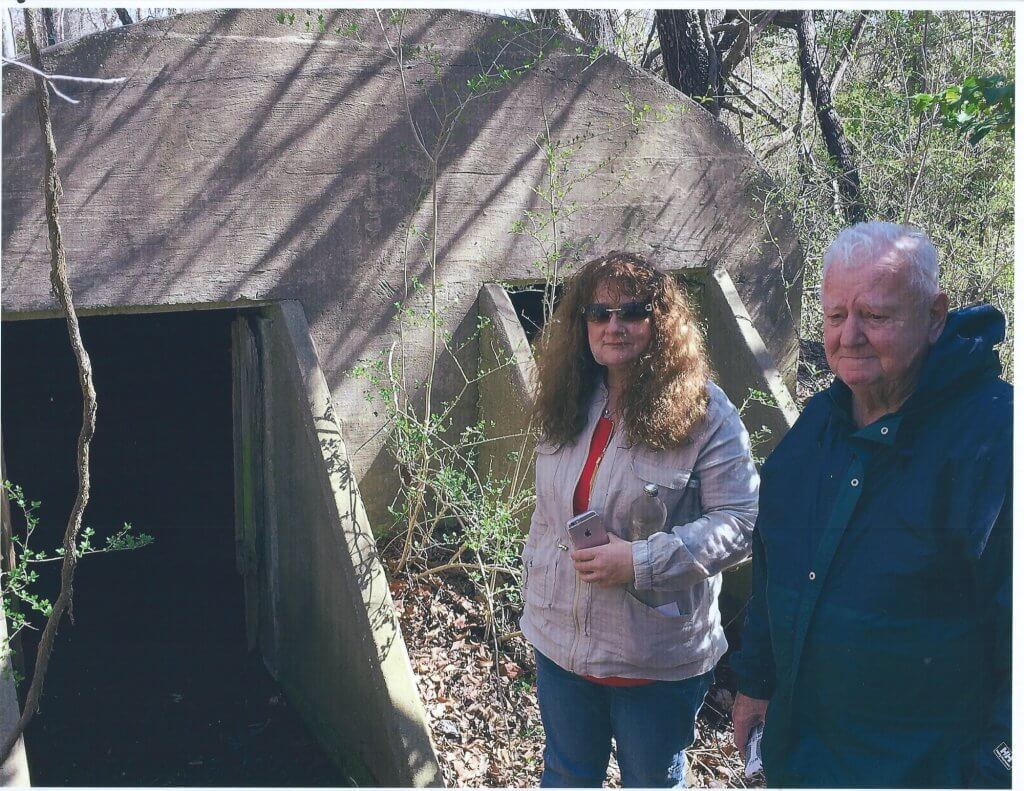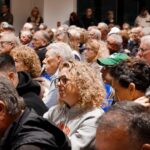CAPE MAY – Three locals took to the woods one recent Sunday afternoon at Cold Spring to try to locate any relics that may have been left from World War I Wissahickon Barracks. The three persons involved are very deeply interested in local Cape May history. Some people go so far as to call them historians, although they themselves do not consider themselves official historians. The three are Laurie (Boyd) Thomas, Herb Pharo, and Bob Elwell, Sr. All three are life long residents of the Cape May area.
Research on Camp Wissahickon had been done for several months prior to their expedition into the woods near the end of the Parkway where Wissahickon Barracks was located 100 years ago during World War I. Ralph Bakley and Ernie Utsch contributed information that helped the trio locate a 100 year old ammunition bunker.
Thomas, Pharo, and Elwell intend to return to what they believe was an ammunition bunker as it was constructed of solid concrete with iron clad doors It contained four chambers, two on each end with a rounded top – all concrete. On each side dirt was pushed up to about within two feet of the top but each end was open for access. They plan to go back and take specific measurements of the bunker and act as amateur archeologists. They are still trying to establish where the different locations of the base were and how it was laid out. (Parade ground, hospital building, headquarters, etc.) Elwell, who is a postcard collector, has many different postcards showing the buildings, parade ground, and some of the activities of the Navy personnel who were stationed at the barracks. However, he has no postcard showing the ammo bunker which the three locals found. Anyone who might have additional information is welcome to contact any of the three. Much is known about World War II in the Cape May area and many organizations talk about it in their programs but like the Vietnam War it seems like World War I in the Cape May area has almost been forgotten. The Cape May area was a bee hive during World War I, the same as it was during World War II The three locals would like to have it more documented so that the history of the Wissahickon Barracks is not lost in time.
It is interesting to note that hundreds of thousands of people drive over what used to be the Wissahickon Base area at the end of the Garden State Parkway. The ammunition bunker is located only hundreds of feet in the woods and may be the only thing found so far that is left of the barracks site.
It is hard to imagine how 8000 sailors impacted the City of Cape May during that period and how they interacted with the local people.
Ten days after the Declaration of War by the United States (April 6, 1917) Lieutenant Commander F. A. Savage and his aide Ensign Julius Zieget following orders established headquarters in room 137 of the Columbia Hotel in Cape May. They set up a Section Base for the United States Navy. This they did at Sewell’s Point where there was an abandoned amusement pavilion which of course is now what we know as the Receiving Center for the United States Coast Guard. Commander Savage commanded that Section Base until April 1, 1918 and the establishing of that base is a history all of its own.
May 22, 1917, the Secretary of the Navy allotted $780,000. out of the Naval Emergency Fund for the “purpose of training members of the Naval Reserve Force for vessels of the coast patrol”. This money resulted in the building and establishing of the Wissahickon Barracks Training Center. Six days later another $300,000. was added to the larger sum because of the urgency of the need, and the war the United States was then engaged in. Also the Fourth Naval District, which the Cape May area consisted of, was believed to have received such a generous appropriation because of the untiring efforts of Lieutenant Thomas Newhall, U.S.N.R.F., who prior to his enrollment in the service worked tirelessly to secure a large training station for the Fourth Naval District. It was understood that none of this money was to be expended for the purchase of ground and it was necessary, therefore to secure a contribution for a site. Professor William Easby, Jr. of the University of Pennsylvania and H. S. Farquhar, a civil engineer, volunteered their services as a selection board. After they considered the suitability of three sites from the standpoint of health and the accessibility to naval centers, they decided upon a farm near Cape May owned by Messrs. Henry Ford and James Cuszens of Detroit, Michigan. (Henry Ford had purchased much of this land from Dr. Emlen Physick with the idea of possibly building his fords at this location because of the railroad accessibility and the Cape May harbor accessibility). This ground which became the site of the Wissahickon Barracks was leased to the U. S. government for the sum of $1.00 per annum. The original purpose of the Wissahickon Barracks Training Center became broadened by the necessities of the service, and it contributed to trained personnel of the Navy without regard to any consideration except its needs. Established at the Wissahickon Barracks was an officers’ material school and schools for training coxswains, quartermasters, gunners’ mates, yeomen, hospital corpsmen, and armed guards. 1529 men were received from other stations and 6577 recruits were received making a total of 8106. Of this number 897 graduated from the armed guards school, and saw duty in the capacity afloat. The remainder were transferred to the Fourth District to meet the needs of its activities and to attend listeners school at New London, Connecticut; signal school, Hampton Roads, Virginia; and engineering school for officers at Pelham Bay, New York and elsewhere.
The outfitting of district vessels kept pace with other rapidly expanding activities of the Fourth Naval District, and at the end of April, but three weeks after war had been declared, eight district patrol craft were commissioned. The first scout patrol vessel to pass the Delaware Capes during war time was the U. S. S. Nevada, S.P. 64 which patrolled the waters of the district north of Cape May to Barnegat. These vessels patrolled harbor entrances so that any hostile craft might be intercepted. Later, commencement of mine sweeping operations were also set up by the Fourth Naval District as the German submarines were laying mines along the Atlantic coast. The Fourth Naval District took in the Delaware Bay and the Chesapeake Bay.
July 21, 1917, a local newspaper had a headline of “Rush New Barracks”. The sub headline read “Home of Naval Militia Were Being Rushed to Completion By Five Hundred Carpenters – Will Be Ready Shortly – Expect Large Number of Men to Occupy Buildings.” The article stated that 500 carpenters working 10 to 12 hours a day, Sundays included, worked on the new Wissahickon Barracks for the Naval militia at Henry Ford’s farm. The Navy department requested that the work on the Wissahickon Barracks buildings be pushed as rapidly as possible and that the Cramp Construction Company of Philadelphia offered as high as $1.20 for overtime. The new barracks housed approximately 6000 members of the Naval militia from the surrounding territory. In addition to the Naval militia part of the property was utilized for the members of the Naval Aviation School which was located there when the barracks were finished. The buildings would include the barracks for the enlisted men, the officers’ quarters, mess halls, a large YMCA building, chapels for religious services, and storage buildings. There also was a large parade ground and recreation fields. The buildings were of frame construction and mostly one story in height. A high fence with guards around it surrounded the property in order to keep out any objectionable persons or alien enemies. There was also a railroad track connecting with the Pennsylvania and Reading Railroads. The tracks were built by the Navy Reserves and were used for carrying materials to the barracks. The men were trained in manning large guns and arrangements and they were given an opportunity to study the big guns at the Bethlehem Steel companies proving grounds while at the barracks. (Bethlehem Steel used Higbees Beach to test their ammunitions).
The Wissahickon barracks had a football team that journeyed as far as Princeton to play their crackerjack Princeton varsity football team. The Cape May sailors also had a strong team and represented some of the foremost colleges in the country. Their quarterback Meadows who played formerly for the University of Pittsburgh was picked for the All-American team in 1916. Fullback Curran was a Bucknell football star and was also an All-American. One of the Cape May sailors first games was played in Atlantic City against the Atlantic City Athletic Club. In 1917 the Cape May sailors on Thanksgiving Day in Washington, D.C. played the Army, represented by Camp Mead officers. The people of Cape May were proud of the Navy team as they represented the City by the Sea.
The Washington Herald (Washington, D. C.) reported on June 4, 1918 that Admiral Cameron McRea Winslow went to Cape May and inspected the training camp of the Naval Reserve Force at the Wissahickon Barracks. All 2700 men training there were kept in camp to be ready to receive the Admiral. He was thoroughly satisfied with their work and said, “reports showed that the camp was one of the healthiest in the nation.” (During this time period there had been serious outbreaks of influenza).
At the beginning of 1920 advertisements were put out by the Cleveland Wrecking Company concerning lumber building materials being sold from the Wissahickon Barracks. Used lumber was a commodity in those days. The war was over and it was to be the war to end all wars. As a result Wissahickon Barracks was to be torn down. The advertisement mentioned yellow pine lumber practically new, doors, windows and frames, sash weights, and roofing materials. Much of the lumber was bought by the locals of Cape May and when Karl Suelke was alive he told Bob Elwell that Karl’s father used some of that lumber to build the Liberty Theater. That connection of history is also now gone.







